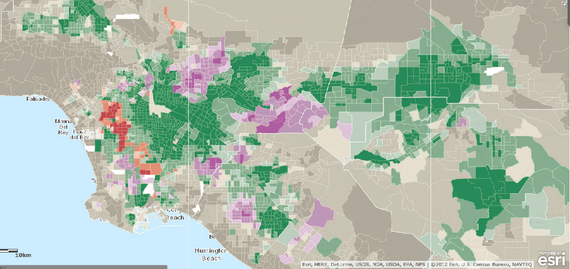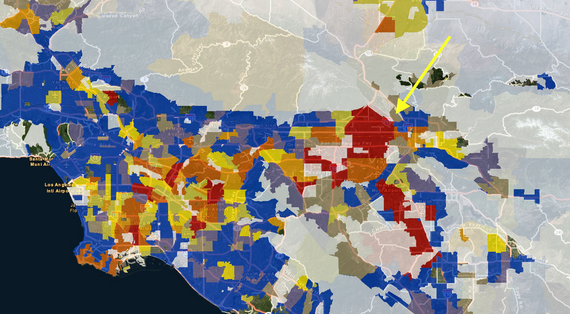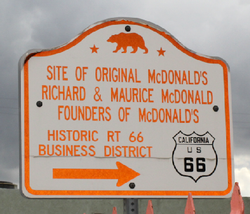Travel Chronicles, From East to West
How the city that gave the world the very first McDonald's hamburger is trying to remake its economy, and other tales

Everyone has got lots of things to think about at the end of a year. But I wanted to note things we've seen, have reported on, and are about to cover in our ongoing travels across the country.
1. This Past Week: Deb Fallows completed her four-installment chronicle of what it is like to cross the continent at low altitude, with various surprises, rewards, and challenges along the way. If you missed them, they are:
- "Flying West From the Winter," on getting out of D.C. just before a big storm
- "Connecting the Dots Over America," day two, with an intended destination of Little Rock and an unexpected stop in Kentucky
- "Revisiting the Atlantic's Dust Bowl Series," Thanksgiving in a historic but surprising location in Oklahoma
- "The Long Stretch Home," on the always-astounding terrain of the American southwest
2. This Coming Week: I will have some wrap-up reports on three larger Eastern/Midwest cities that John Tierney and Deb have written about extensively: Columbus, Ohio; Pittsburgh, Pennsylvania; and Charleston, West Virginia. Plus, a bonus year-end item about the things I know (or think I do)—about America's economy, its civic fabric, its trouble signs, and its promise—that I didn't know a year ago, before spending time in places from Mississippi, to central California, to coastal Georgia, to Pennsylvania, to Minnesota and Wisconsin, to Ohio and West Virginia.
3. For the Weeks Ahead: We'll be in the western half of the country, with stops planned from Oregon to Arizona to Montana and points in between.
Including: early on, a report on San Bernardino, a place I've known all my life and that is on the list with Detroit and Stockton among major cities forced into bankruptcy following the financial crash of 2008. That crash was particularly devastating in San Bernardino's part of the Southern California "Inland Empire" since, for reasons we'll get into, it was one of the very most-exposed parts of the country to the real-estate bubble of the "subprime mortgage" years. Over the past 18 months, we've been writing about cities and regions that have figured out answers to their economic and political challenges. This will be an examination of a place still grappling with really profound challenges.
The San Bernardino story is partly a California-ethnic story. The Esri map below shows the predominant ethnic groups, by zip code, in Southern California: green for Latino, magenta for Asian, red for African-American (largely in south-central LA), gray or beige for white. The Latino concentration at the upper right side of the view is the Fontana-Colton-San Bernardino expanse, which enjoyed California's strongest job growth in the years before the 2008 crash but has suffered very badly since. (I'll include an interactive version of this map in later posts.) There's another green concentration southeast of that, in the Moreno Valley area. If you overlaid this map with one showing mortgage problems after the crash, you'd see a close match.

Partly the story is about industrial choice. This map, from the Institute for Spatial Economic Analysis at the University of Redlands, highlights something unusual: the proportion of a regional economy based on logistics. Transport, warehousing, distribution, storage—the areas in red have logistics-heavy economies, with particular strengths and weaknesses we'll talk about further. Again that's the Fontana-Colton-San Bernardino area in red, and highlighted by the yellow arrow.

Logistics involves a lot of things: railroad lines, which came over the Cajon Pass to this area; freeways, with several N-S and E-W routes intersecting here (Route 66 ran through San Bernardino, as you may recall from the song); warehouse sites, which have been built in huge expanses of a dry river bed; and an airport, which plays a central role in the San Bernardino story.

on E Street in San Bernardino
San Bernardino had historically been a tough, blue-collar town. But from World War II through all the Cold War years, it has also been the home of Norton Air Force Base, where thousands of airmen and officers were based. When I was growing up in nearby Redlands, enormous bombers and transport planes from Norton would circle over our school yards all day long; teachers would routinely pause during class time to wait for sonic booms from the jets to subside. Through the 1980s, the base had supported well over 10,000 local jobs. But as part of the post-Cold War base-closing movement, Norton was deemed unnecessary in 1988 and entirely shuttered by 1994. Norton's closing, plus the demise of Kaiser Steel in nearby Fontana, "ripped a part of the heart out of the San Bernardino area economy,” the local economist John Husing told the San Bernardino Sun. “And really in many respects the bankruptcy of San Bernardino today can be traced back to events in that period of time.”
Unlike some other now-closed bases, much of the physical infrastructure of the former Norton AFB is still intact. It's become the San Bernardino International Airport, which has been the focus of an expensive (and controversial) effort to make it a transport and logistics hub for an area with heavily overburdened infrastructure of all sorts. The runway there, which once handled bombers, is big enough for any airliner or cargo plane. The city has invested in a beautiful new terminal to make itself a center for new traffic. Here is how it looked when we were there yesterday, with everything you can see except the mountains or clouds being part of the vast airport complex.

It's one of several assets ready for use, that the city is trying to put together to make a new start, against considerable odds. More to come about the efforts, and the obstacles, in future installments.
* To read about and sign-up for our new American Futures email newsletter, see here. Or just go straight to the sign-up here.